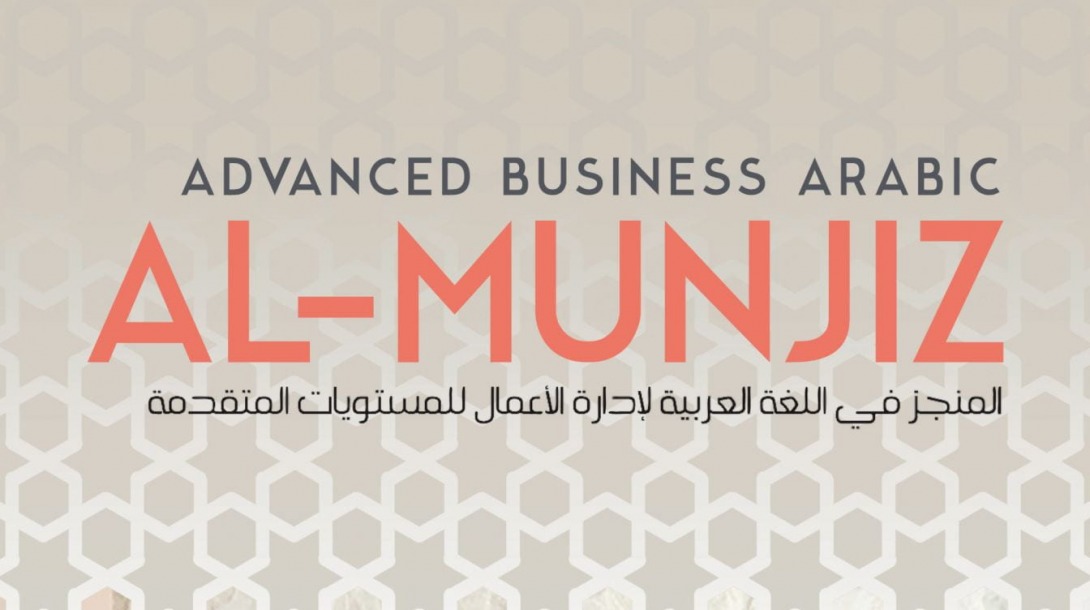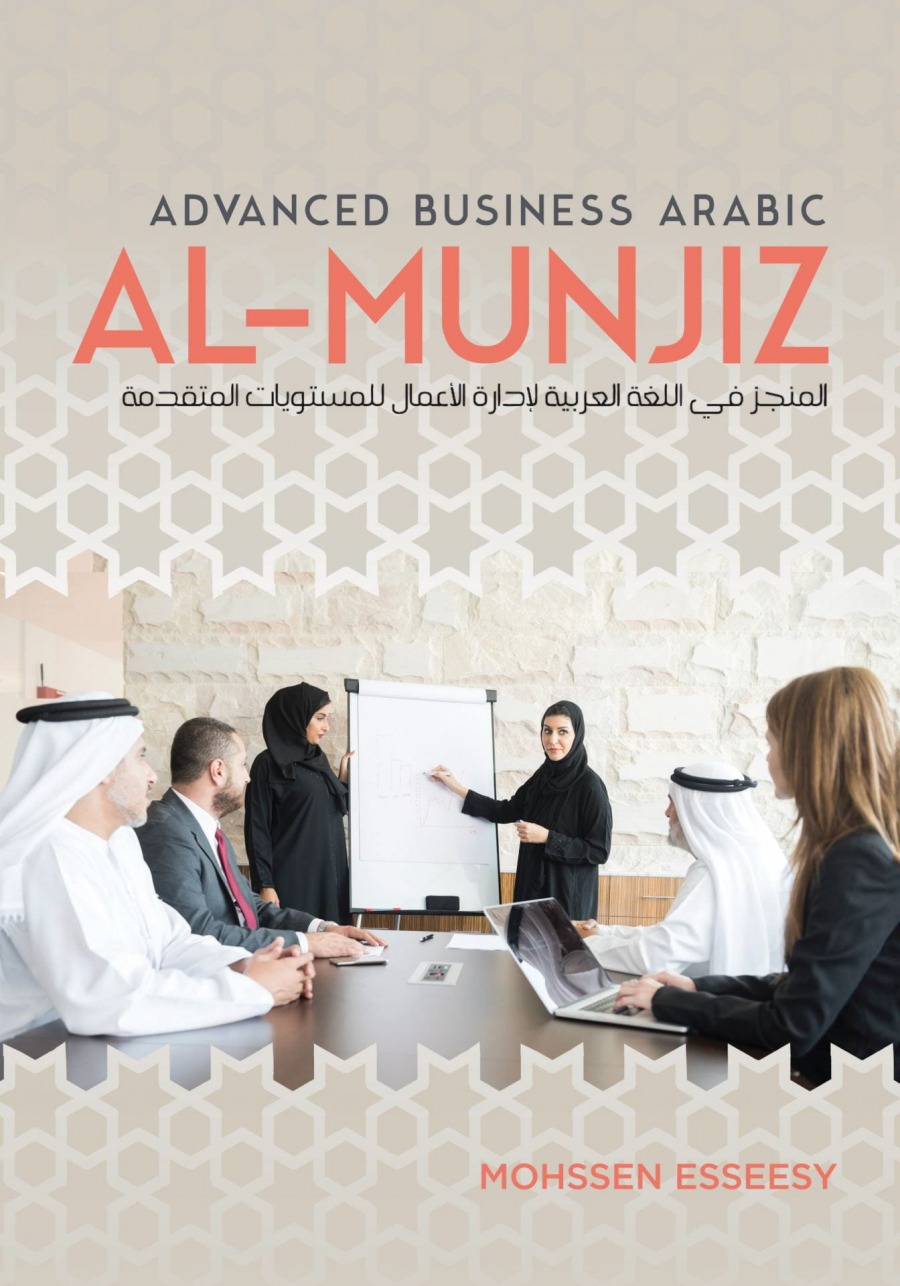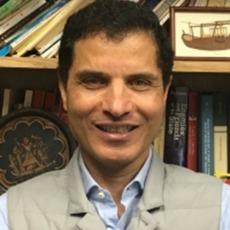Faculty Book Spotlight: Al-Munjiz Advanced Business Arabic

How did you come up with the idea of writing a textbook on Business Arabic?
My interest in business Arabic began in 2008, when GW-CIBER expanded its scope to include business languages. With a small seed grant I received from CIBER (GW’s Center for International Business Education and Research), I excitedly began developing materials for a full course in business Arabic. Part of my excitement was that I found it to be an opportunity to reactivate and harness my academic background in international business and integrate it with my academic training in applied linguistics and extensive professional experience in teaching and conducting research in Arabic. As soon as I began developing the curriculum for a full course in business for upper-level undergraduate students, I noticed a critical gap in the field, namely the lack of appropriate authentic and interactive material for the 21st century teaching and learning. This curricular gap, while a challenge then, turned into an opportunity to fill it with up-to-date, classroom-tested textbook material, which meets the academic and professional needs of today’s Arabic language learners.

How has your academic and professional experience as an Arabic linguist and as the coordinator of the Arabic program at GW informed your decision to write a book on business Arabic and the writing process?
The international business concentration of my M.A. in Near Eastern and North African Studies, along with my Ph.D. in Arabic (linguistics), the applied linguistics research I conducted, and my extensive teaching experience in higher educations—all have prepared me for the writing of al-Munjiz: Advanced Business Arabic. The writing process was incremental and required many steps: developing the pedagogical goals of each textbook module, carefully selecting texts at the intended advanced level with appropriate business content that fits the theme of the module contributes to the goals of the module, developing stimulating exercises integrated with research-based activities to be carried out by the textbook user, simulation practice, and culminates with a challenging case study—commonly used in business curricula—closely related the theme and content of the module, which requires a well-reasoned and defensible solution on the part of the learner.
These are the principles that guided the selection of materials and design of instructional activities: (1) challenging contemporary authentic, and author-composed materials equating published ones in each domain. (2) stimulating and meaningful instructional activities simulating those found in “real life” and motivating the learner to perform her/his best. (3) Utilizing lexico-grammatical knowledge to bridge the gap in processing business content. (4) Promoting learner’s autonomy by motivating him/her to be an active, confident learner who conducts own research to complete a task or assignment. (5) increasing analytical abilities through critical thinking in the process of evaluation of data, synthesizing details before formulating an opinion or recommending solutions to business-related challenges.
Who is this textbook intended for?
Al-Munjiz: Advanced Business Arabic fills an existing critical curricular gap in foreign language education for non-native learners of Arabic. It integrates the Arabic language and business content in thematic modules of high interest for a broad spectrum of learners of Arabic. The six major business domains contained within: business geography, employment, Islamic banking, fuel and energy, e-commerce, and tourism, are intended for undergraduates, graduate students, business professionals, business establishments seeking to train its nonnative workforce in Arabic, and for anyone whose primary focus is business in the Arabic-speaking regions.
How is this textbook situated in the wider field of language pedagogy? What are the innovative aspects of it?
This business-focused textbook is the first to be published after a twenty-year hiatus in Arabic. It is also the first textbook to integrate business modules with exercise requiring data collection and analysis, and the first to adopt the case study method. The innovative content and approach in this textbook foster learner autonomy while targeting the development of language and business skills that commensurate with the expectations for college and advanced degree students to assume an appropriate corporate position in the business world, where they likely use higher order skills such as conducting research, evaluating data, and recommending solutions to business challenges. As such, this curriculum distinguishes itself from existing ones, which focuses on tasks that are transactional in nature and often do not sufficiently lend themselves to the development of high order skills.
Learners using this textbook are offered not only language, idiomatic and formulaic expressions of the business domain, but also the conventions and cultural norms of Arab businesses and practices. Strategies and skills that contribute to increased language proficiency efficiently such as pre-reading activation exercises, skimming, scanning, paraphrasing, expressing and supporting opinions, which are contained within are geared towards encouraging the learner to delve deeper into the various business-related contexts with increasing confidence.
What is it that this textbook adds to current Arabic textbooks?
One of the main contributions this textbook makes to fill the existing curricular gap in business language education in Arabic is providing its users the opportunity to learn from the business and economics scholars and CEOs across several key business domains in the recorded interviews I had in a number of Arab states, as I developed the textbook materials. Those interviews provide first-hand knowledge not only of the specific business domain but also the sociocultural environment in which each business entity operates. Additionally, the textbook affords the learner the opportunity to become acquainted with the factors that facilitate or otherwise impede the business establishment. The textbook content helps enhance its users’ self-confidence through practicing simulated situations they likely encounter in “real” business contexts (e.g., developing their own resume, responding to a job ad, and analyzing the foreign exchange markets, and energy and fuel markets).
Users of the instructional material in the textbook conduct guided online research utilizing the language tools and (re)constructed knowledge from content to fulfill certain required tasks. Similarly, learners engage in problem analysis and solving of the case study present in the module to demonstrate their mastery over content and confidence in their language skills to successfully complete the business-focused tasks. To demonstrate their progress, learners apply the concepts they learned from the business and culture content while using the language tools they sharpened when working on individual or group tasks and assignments. Finally, each module ends with a few suggested further readings, which can be utilized as springboard for extensive readings in a personalized reading project on a business topic. Two handy specialized business-focused glossaries (Arabic-English and English-Arabic) at the end of the textbook are incorporated as a reference for specialized business terms organized by thematic module.
Can you share with us some of the fun and challenging aspects about the process of collecting material for this book?
Recording interviews with business and economics academics and CEOs was unexpectedly quite challenging. Identifying and selecting the scholars and CEOs, coordinating and setting up the interviews and traveling halfway around the world and finding a competent videographer overseas were some of the most unexpectedly challenging but also rewarding aspects in the development of the textbook.
What are the recommendations that you would give to an Arabic instructor or an Arabic program coordinator who would like to adopt your textbook?
This book is unlike a traditional textbook where there is an established sequence for covering the book units. The modules in al-Munjiz are self-contained and allow maximal flexibility in the choice of the modules and their sequence for class. In a standard 3-credit course, this textbook can be realistically fully covered in a two-course sequence.
It is highly recommended that the course instructor surveys the students before the first class meeting to find out which modules they wish to study in the semester. Doing so, will arouse the students’ interest and make them feel invested in the selection of the content they are about to learn.
Also, while the language variety in the book is Modern Standard Arabic (MSA), it is highly recommended that the business language instructor reserves time in class for integration of a spoken vernacular with MSA.
Each module roughly follows a predictable format that integrates all the four language skills, reading, writing, speaking, and listening plus culture.
Follow us on GW-CIBER website to find out teacher-training opportunities through the periodic seminars focusing on business language teaching at https://business.gwu.edu/research/ciber/business-languages-program
About the Author
-

Prof. Mohssen Esseesy Trained in linguistics, Dr. Esseesy’s research encompasses historical and applied linguistics. Within historical linguistics, his research focuses on language change by grammaticalization in Arabic and Semitic. Within applied linguistics, his research interest includes language for specific purposes, particularly business language; curriculum development; and foreign language pedagogy and assessment. Dr. Esseesy is a Professor of Arabic and International Affairs, the former Chair of the Department of Classical and Near Eastern Language and Civilizations (CNELC) (2014-2020), CNELC Deputy Chair (2012-2014); and the former Executive Director of the GW Summer National Security Internship (2008-2010). Dr. Esseesy is the Co-editor of the Global Business Languages journal and is a member of the GW-CIBER, and the Steering-Committee of the Institute of Middle East Studies at the Elliott School of International Affairs. Dr. Esseesy is a member of the editorial board of the Routledge Language Studies in Language and Identity (RSLI) series. He served a three-year term as an elected member of the Executive Board of the American Association of Teachers of Arabic (AATA) (2003-2005).